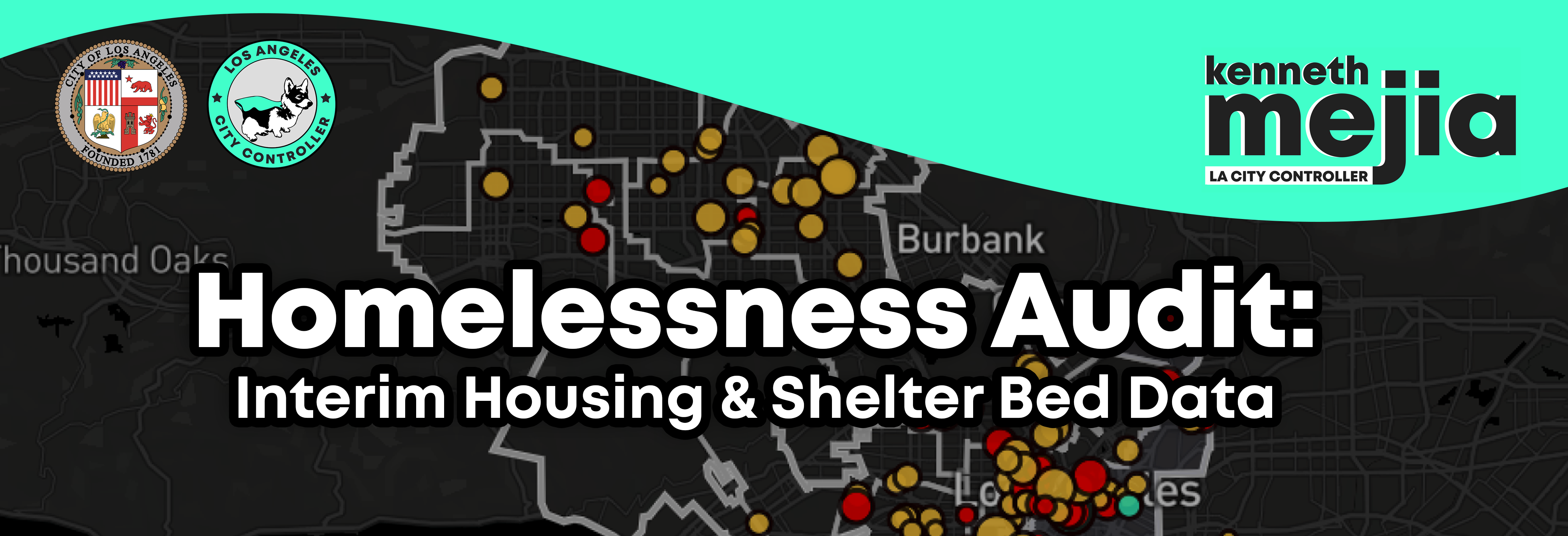Homelessness Audit: Interim Housing & Shelter Bed Data

December 5, 2023
Honorable Karen Bass, Mayor
Honorable Hydee Feldstein Soto, City Attorney
Honorable Members of the Los Angeles City Council
RE: Interim Housing Bed Availability Data
The results of the 2023 Greater Los Angeles Homeless count revealed that an estimated 46,260 people in the City were experiencing either sheltered or unsheltered homelessness, a figure exceeding the number of interim housing beds by nearly three times (16,100 beds). In December of 2022, Mayor Karen Bass declared a warranted State of Emergency around the homelessness crisis. Yet the woefully inadequate amount of both interim and permanent housing resources, as well as the antiquated and inefficient methods of data collection and housing referral processes, significantly inhibit efforts by the City to respond to the crisis with the urgency that it requires.
In this audit, our office worked to analyze and review current methods used to gather, use, and improve interim housing data. Due to the extremely limited amount of interim housing beds within city limits, it is vital that we maximize their use and ensure that providers know, on an up-to-date and day-to-day basis, when beds become available. Achieving this requires good quality data and a high level of coordination between outreach workers, program operators, and others to place participants into a shelter.
Right now, as documented by our Office’s audit, the systems and data are lacking. We found:
- • Data entry issues related to participant enrollments and exits, and bed attendance data
- • LAHSA did not follow up with interim housing providers on their point-in-time sheltered homeless count data, despite red flags indicating potential data quality issues.
- • A significant number of shelters have recently reported low bed utilization rates, increasing the risk that the number of sheltered homeless is being undercounted and that available beds may not be used efficiently.
- • LAHSA attempted to develop a public facing shelter bed availability system (Find-a-Shelter) in the past, but low participation rates by providers and inaccurate data limited the usefulness of the system.
- • LAHSA’s current system for tracking bed availability (Bed Reservation System) is so unreliable that LAHSA relies on daily census emails to track bed availability, rather than the reservation system.
These data quality issues make it next to impossible for the City to have an accurate picture of how many beds we actually have available, and how many are being utilized in the City at any given time. When this information is considered alongside laws like Los Angeles Municipal Code section 41.18 - which prohibits unhoused individuals from sitting, sleeping, or lying in designated areas, having reliable information about shelter bed availability is crucial to assessing the City's adherence to the Constitutional rights of unhoused individuals. Under a federal court's decision in the case of Martin v. Boise, the City of Los Angeles and other local jurisdictions in several western states cannot enforce local laws restricting camping in public spaces if they do not have sufficient shelter beds available for their homeless population.
We recommend that the City collaborate with LAHSA to take new steps to create a functioning shelter bed availability system, and improve the data quality that supports the existing shelter system. Changes are necessary not only because of the work LAHSA has carried out over the recent years, but because of its expanding responsibility in newer City efforts, like Inside Safe. Specifically, LAHSA should:
- • Re-evaluate its information requirements and redesign a shelter bed availability system that is publicly accessible to facilitate referrals to all LAHSA-funded shelters;
- • Develop and implement a plan to monitor, evaluate, and enforce its requirements on shelter program operators to enter bed availability and bed attendance data in a complete, accurate, and timely manner; and
- • Follow up with all shelter program operators participating in the Annual Homeless Count that report bed utilization rates below 65% or more than 105%, and require them to correct their count of people experiencing homelessness in their shelter, or provide an explanation for low or high bed utilization rates.
As this audit reveals, the City currently lacks a centralized database that tracks interim housing availability and criteria for entry for interim housing sites.
To illustrate what our City needs, our team is launching an interim housing bed availability map that, while incomplete, serves as an example of what we could accomplish with more coordinated efforts across relevant stakeholders. The goal of this project is to centralize data on interim housing to make the landscape of resources more accessible and easier to understand. To date, our team has attempted to contact more than 350 interim housing sites in the City. We have collected information on population(s) served, requirements for entry, referral processes, current bed availability, and daily reporting practices for all sites.
With the work we have done thus far, we believe that a system like this is possible. We invite all necessary stakeholders (including LAHSA and the service providers that it works with) to join efforts and make an achievable dream a reality: the people of Los Angeles, including all of its unhoused neighbors, should know how many interim shelter beds are available on any given night.
Respectfully submitted,

KENNETH MEJIA
City Controller